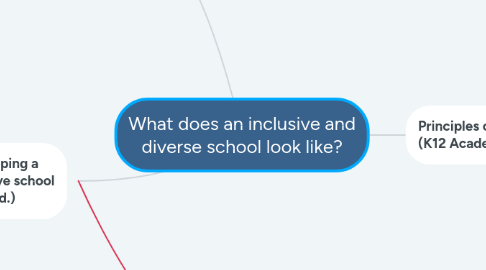
1. definition of diversity: "The sum of the ways that people are both alike and different." (NEA, n.d.)
2. Principles of Inclusion (K12 Academics, n.d.)
2.1. "All children have an inherent right to education."
2.2. "No child is excluded from, or discriminated within education on grounds of race, color, sex, language, religion, political or other opinion, national, ethnic or social origin, disability, birth, poverty or other status"
2.2.1. the term "discriminated" is a tenuous one. While it is often used in a negative context, it is true that teachers must acknowledge, adapt and differentiate for differences, in this case, they are discriminating in a positive context that values equity over equality.
2.3. "Schools adapt to the needs of children, rather than children adapting to the needs of the school"
2.3.1. While this is the ideal, there are cases where this is not always immediately possible. Students requiring special staff or medical support do not always come with the resources that teachers need to adapt even if they are willing.
2.3.1.1. Transparency and honesty are important.
2.4. "Children's views are listened to and taken seriously."
2.4.1. "Learner Agency" (IBO)
2.5. "Individual differences between children are a source of richness and diversity, and not a problem."
2.5.1. Teachers must intentionally create environments which celebrate differences rather than emphasize sameness.
2.6. "The diversity of needs and pace of development of children are addressed through a wide and flexible range of responses." - Teacher Practices
2.6.1. "Signage should represent all types of cultures."
2.6.2. "Build a strong sense of community for all, recognizing the contributions of diverse members."
2.6.3. "Collaborate with diverse professionals to include alternate view points."
2.6.3.1. Diverse staff in school
2.6.4. "Offer additional assistance and resources in home language."
2.6.5. "Be introspective of personal bias, work toward eradicating stereotypes."
2.6.6. "Educate staff of the backgrounds of students and explore their culture."
2.6.7. "Professional Development for staff on ways to be culturally responsive."
2.6.7.1. Barriers to learning
2.6.8. "Student character training with emphasis on diversity."
2.6.9. "Select resources that offer diverse characterization/subjects."
2.6.9.1. Classroom
2.6.9.2. School Library
2.6.9.3. Online media
2.6.9.4. Include diverse school community members as "resources"
2.6.10. "Provide representation/image of cultural diversity."
2.6.11. "Celebrations/holidays should include all cultures."
2.6.12. "Offer additional support classes and/or tutoring."
2.6.12.1. Language Support
2.6.12.2. After School homework help
2.6.12.3. Connect with community tutoring / support networks
2.6.13. "Intentional grouping of students to include diversity."
2.6.13.1. Use of visual thinking strategies to help students regroup along a variety of contexts to literally allow them to see each other as same and different from various perspectives.
2.6.14. "Have a buddy system to ease the transition period for students."
2.6.15. "Develop personal relationships with students and their families."
2.6.15.1. This is a key point from which other responses must flow. When in good relationship, it is easier to gauge which responses are desired and appropriate.
3. Practices of developing a diverse and inclusive school (K12 Academics, n.d.)
3.1. "Understanding inclusion as a continuing process, not a one-time event"
3.1.1. Administrators and teachers co-develop an intentional timeline that targets and works towards inclusion.
3.1.1.1. review and update regularly
3.2. "Strengthening and sustaining the participation of children, teachers, parents and community members in the work of the school"
3.2.1. Intentional parent education
3.2.1.1. Learner Profile
3.2.1.2. School Policies
3.2.1.3. Best practices on Parent-Parent / Parent-Student/ Parent-Teacher interactions.
3.2.2. PTA
3.2.2.1. Co-create community events with diversity and inclusion in mind.
3.2.3. Hiring a diverse school staff
3.3. Restructuring the cultures, policies and practices in schools to respond to the diversity of pupils within their locality. Inclusive settings focus on identifying and then reducing the barriers to learning and participation, rather than on what is 'special' about the individual child or group of children, and targeting services to address the 'problem'
3.3.1. Language Policy
3.3.1.1. review and update regularly
3.3.2. Assessment Policy
3.3.2.1. review and update regularly
3.3.3. IEP's
3.3.3.1. review and update regularly
3.3.4. Language Support
3.3.4.1. Multiple languages as needed
3.3.5. Professional Medical Support
3.3.5.1. Develop networks between the medical and school community.
3.3.6. School Mission/Vision Statement to include intention for diversity and inclusiveness.
3.4. Providing an accessible curriculum, appropriate training programs for teachers, and for all students, the provision of fully accessible information, environments and support
3.4.1. Create time within the academic year without classes for regular teacher professional development and set aside appropriate budget
